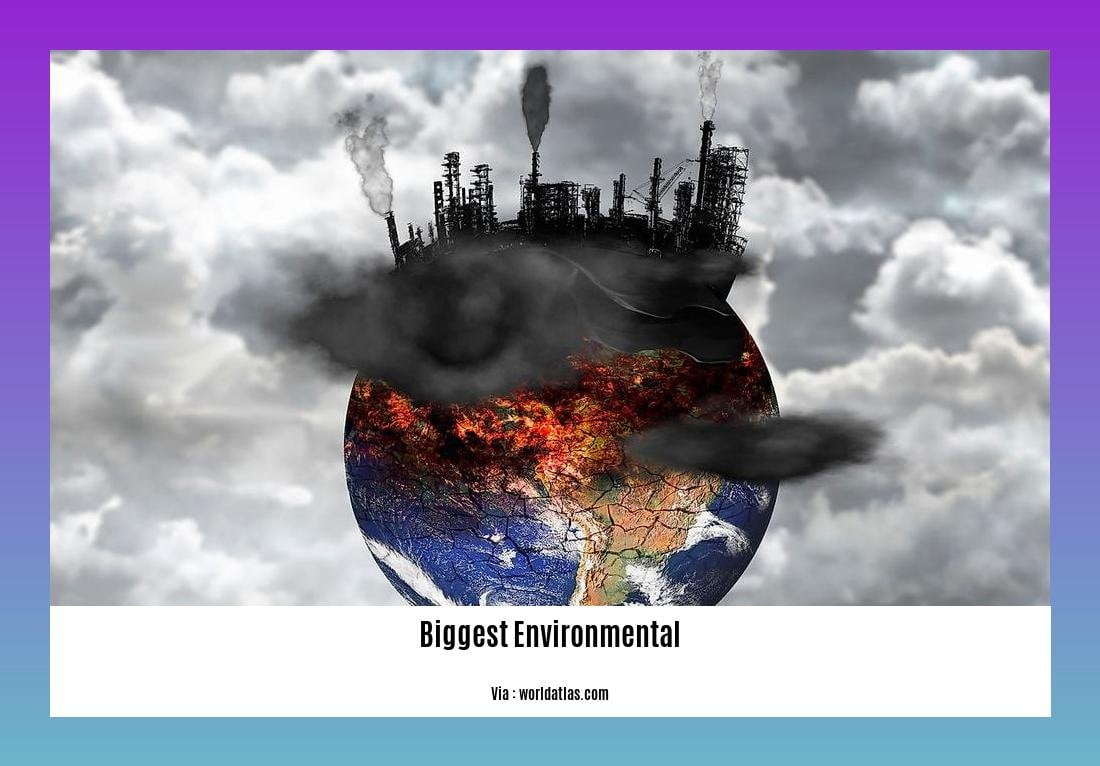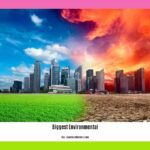Unveiling the Biggest Environmental Issues in the World: From Climate Change to Deforestation
In a world grappling with an ever-increasing burden on its delicate ecosystems, it is essential to shed light on the most pressing environmental issues we face. From the ominous specter of climate change to the devastating consequences of deforestation, these challenges demand our immediate attention and concerted efforts. With a profound understanding of the intricate web connecting human activities and the environment, this article seeks to explore and dissect the biggest environmental issues plaguing our planet. Through an engaging exploration of topics such as environmental policy, air and water pollution, overpopulation, and endangered species preservation, we hope to inspire awareness, foster change, and pave the way for a sustainable future for generations to come.
Key Takeaways:
- Climate change, deforestation, air and water pollution, overpopulation, and endangered species preservation are some of the biggest environmental issues facing our planet.
- An experienced environmental journalist with a comprehensive understanding of these challenges can effectively communicate the intricate connections between human activities and the environment.
- Environmental policy plays a crucial role in addressing and mitigating these problems.
- Raising awareness about these issues is essential in inspiring positive action and fostering a more sustainable future for generations to come.
Biggest Environmental Issues in the World

Climate Change: A Global Crisis
Climate change stands as one of the biggest environmental issues in the world, threatening the very foundation of our planet. The relentless emission of greenhouse gases, primarily carbon dioxide, traps heat within the Earth’s atmosphere, leading to rising temperatures. The consequences are far-reaching, from extreme weather events to the accelerated melting of ice caps and rising sea levels.
Mass Deforestation: A Loss of Biodiversity
Another major environmental concern lies in mass deforestation, where vast swathes of forests are cleared for agriculture, logging, or infrastructure development. This destruction disrupts delicate ecosystems, exacerbating climate change and robbing countless species of their natural habitats. The loss of diverse plant and animal life threatens the intricate balance of our planet’s ecosystems, with implications for human health and well-being.
Air and Water Pollution: Imperiled Resources
The pervasive issues of air and water pollution remain pressing global challenges. Human activities, such as industrial emissions, agricultural runoff, and improper waste disposal, contaminate both the air we breathe and the water we drink. Polluted air contributes to respiratory diseases and other health complications, while polluted water jeopardizes aquatic life and endangers human communities.
Overpopulation: Straining Earth’s Resources
Overpopulation looms as a critical environmental issue in the world, placing immense strain on Earth’s finite resources. As our global population continues to soar, demands for food, water, and energy escalate, leading to increased deforestation, pollution, and habitat loss. Balancing population growth with sustainable resource management is essential to ensure a thriving future for our planet.
Endangered Species Preservation: Protecting Earth’s Wildlife
The preservation of endangered species holds great significance in safeguarding the delicate web of life on Earth. Human activities, such as habitat destruction, poaching, and climate change, push numerous species to the brink of extinction. By focusing our efforts on species conservation, we protect biodiversity, maintain ecosystem services, and contribute to the resilience of our planet.
In conclusion, the biggest environmental issues in the world demand urgent attention and collective action. Climate change, mass deforestation, air and water pollution, overpopulation, and endangered species preservation are deeply interconnected challenges that require comprehensive solutions. By fostering environmental awareness and promoting sustainable practices, we can pave the way for a greener, more resilient future for generations to come. Now is the time to act, working together to address these critical issues and preserve the beauty and diversity of our planet.
One of the biggest environmental challenges we face today is the need to address climate change. To learn more about this pressing issue, click here.
Deforestation and Loss of Biodiversity
Deforestation and loss of biodiversity are two of the biggest environmental issues in the world. The destruction of forests and the resulting decline in biodiversity have far-reaching consequences for our planet’s ecosystems and the delicate balance of life. In this article, we will delve into these critical issues, exploring their causes, impacts, and potential solutions.
The Causes and Impacts of Deforestation
Deforestation refers to the permanent removal of trees from forests, resulting in the conversion of valuable ecosystems into non-forest land. The primary drivers of deforestation include agricultural expansion, logging, mining, and urbanization. These activities contribute to habitat destruction, leading to a significant loss of plant and animal species.
Key Takeaways:
– Deforestation is primarily caused by agricultural expansion, logging, mining, and urbanization.
– It leads to habitat destruction and a significant loss of plant and animal species.
The impacts of deforestation are manifold. Trees play a crucial role in absorbing carbon dioxide and releasing oxygen, making deforestation a major contributor to greenhouse gas emissions and climate change. Moreover, forests serve as vital habitats for millions of species, and their destruction disrupts intricate ecosystems, leading to a decline in biodiversity. Deforestation also results in soil erosion, loss of water regulation, and increased vulnerability to natural disasters.
Loss of Biodiversity: A Silent Crisis
Biodiversity encompasses the incredible variety of life on Earth. It includes the diversity of species, ecosystems, and genetic resources. However, due to various human activities, we are currently facing a silent crisis of biodiversity loss, with species disappearing at an alarming rate.
Key Takeaways:
– Biodiversity loss refers to the alarming decline in species and ecosystems.
– Human activities are the primary cause of this crisis.
The loss of biodiversity has far-reaching consequences. Each species plays a vital role in maintaining the balance of ecosystems and providing essential ecosystem services. Biodiversity loss leads to reduced resilience, making ecosystems more vulnerable to disturbances and less capable of providing vital services such as clean air and water, erosion control, and pollination.
Potential Solutions: A Path to Restoration
Addressing deforestation and loss of biodiversity requires a multi-faceted approach. Governments, organizations, and individuals must collaborate to implement effective solutions that prioritize the preservation and restoration of forests and the protection of habitats.
One crucial strategy is the establishment and enforcement of protected areas and wildlife reserves. These areas serve as refuges for endangered species and play a crucial role in preserving biodiversity. Additionally, promoting sustainable land-use practices, such as agroforestry and reforestation, can help mitigate deforestation and restore ecosystems.
Key Takeaways:
– Establishing protected areas and wildlife reserves is crucial for preserving biodiversity.
– Promoting sustainable land-use practices can help mitigate deforestation and restore ecosystems.
Furthermore, it is essential to raise awareness about the importance of biodiversity and the consequences of deforestation. By fostering environmental education and encouraging sustainable lifestyles, we can empower individuals to make informed choices and contribute to the conservation of our planet’s invaluable resources.
In conclusion, deforestation and loss of biodiversity are pressing environmental issues that demand our attention and collective action. The destruction of forests and the decline in biodiversity have far-reaching consequences, affecting everything from climate regulation to the provision of essential resources. By understanding the causes, impacts, and potential solutions, we can work towards a more sustainable future, safeguarding our planet’s invaluable biodiversity for generations to come.
Key Takeaways:
– Deforestation and loss of biodiversity demand collective action and awareness.
– Solutions include protected areas, sustainable land-use practices, and environmental education.
Sources:
– Source 1
– Source 2
Air Pollution and Its Impact on Human Health

Air pollution is a significant global environmental issue that poses a serious threat to human health. The presence of harmful pollutants in the air can have detrimental effects on both the respiratory and cardiovascular systems, leading to a range of health problems. In this article, we will delve into the impact of air pollution on human health, exploring the causes, consequences, and potential solutions to this pressing issue.
The Link Between Air Pollution and Human Health
Air pollution refers to the contamination of the air by harmful substances, including particulate matter, nitrogen oxides, sulfur dioxide, and volatile organic compounds. These pollutants are released into the atmosphere from various sources, such as industrial emissions, vehicle exhaust, and burning of fossil fuels. When inhaled, these pollutants can enter our respiratory system and have immediate or long-term effects on our health.
Health Effects of Air Pollution
Exposure to high levels of air pollution has been linked to a wide range of health problems. The impact varies depending on the type and concentration of pollutants, as well as individual susceptibility. Here are some key health effects associated with air pollution:
- Respiratory Issues:
Long-term exposure to air pollution can contribute to the development or exacerbation of respiratory conditions such as asthma, bronchitis, and chronic obstructive pulmonary disease (COPD). The pollutants can irritate the airways, leading to inflammation and reduced lung function.
Cardiovascular Diseases:
Studies have shown a clear connection between air pollution and cardiovascular diseases, including heart attacks, strokes, and high blood pressure. The presence of pollutants in the air can increase the risk of blood clot formation, inflammation, and damage to the blood vessels, leading to cardiovascular problems.
Impaired Lung Development:
Children exposed to air pollution during critical stages of lung development may experience impaired lung function and reduced respiratory capacity. This can have long-term implications for their overall health and well-being.
Increased Mortality:
- The World Health Organization estimates that around 4.2 million premature deaths globally are attributed to outdoor air pollution each year. These deaths are primarily caused by respiratory diseases, cardiovascular conditions, and lung cancer.
Sources of Air Pollution
To better understand the impact of air pollution on human health, it is crucial to identify the sources from which these pollutants originate. While natural events such as volcanic eruptions and wildfires can contribute to air pollution, human activities are the primary drivers. Some significant sources of air pollution include:
- Industrial Emissions:
Industrial processes, particularly those involved in the production of energy, chemicals, and manufacturing, release substantial amounts of pollutants into the atmosphere. These emissions, consisting of particles and toxic gases, can lead to severe air pollution in nearby communities.
Vehicle Exhaust:
The combustion of fossil fuels in vehicles releases a variety of pollutants, including carbon monoxide, nitrogen oxides, and particulate matter. Areas with heavy traffic often experience high levels of air pollution.
Burning of Fossil Fuels:
Power generation from fossil fuels, such as coal and oil, is a major contributor to air pollution. The release of pollutants during the combustion process significantly impacts air quality and human health.
Agricultural Activities:
- Agricultural practices, such as the burning of crop residues and the use of fertilizers, contribute to air pollution. These activities release pollutants like ammonia and volatile organic compounds, which can have adverse effects on human health.
Mitigating the Effects of Air Pollution
Addressing air pollution requires collective efforts from individuals, industries, and governments. Here are some key strategies to mitigate the effects of air pollution and protect human health:
- Transition to Clean Energy Sources:
Shifting away from fossil fuels towards renewable energy sources, such as solar and wind power, can significantly reduce air pollution. Encouraging the adoption of clean energy technologies and supporting sustainable energy policies is crucial.
Improved Industrial Practices:
Industries must adopt cleaner technologies and practices to minimize their emissions. Implementing stringent regulations and enforcing pollution control measures can help reduce the release of harmful pollutants into the air.
Promote Sustainable Transportation:
Encouraging the use of public transportation, cycling, and walking can help reduce vehicle emissions and improve air quality. Investing in infrastructure for electric vehicles and promoting the development of sustainable transportation systems are essential steps.
Raise Awareness:
- Education and awareness campaigns play a crucial role in informing the public about the harmful effects of air pollution on human health. By increasing awareness, individuals can make informed choices to minimize their contribution to air pollution and protect their well-being.
Key Takeaways:
- Air pollution poses a significant threat to human health, with both immediate and long-term impacts on respiratory and cardiovascular systems.
- Health effects of air pollution include respiratory issues, cardiovascular diseases, impaired lung development, and increased mortality.
- Industrial emissions, vehicle exhaust, burning of fossil fuels, and agricultural activities are major sources of air pollution.
- To mitigate the effects of air pollution, transitioning to clean energy sources, improving industrial practices, promoting sustainable transportation, and raising awareness are crucial steps.
Overpopulation and its Strain on Resources
Key Takeaways:
– Overpopulation is a pressing environmental issue that puts a strain on Earth’s finite resources.
– As the human population continues to grow, the demand for resources such as food, water, and energy increases.
– Overpopulation exacerbates issues like deforestation, pollution, and habitat loss, leading to further environmental degradation.
– Sustainable population management and resource conservation are crucial for a more sustainable future.
With the world’s population steadily increasing, overpopulation has become a significant environmental issue that cannot be ignored. The growing number of people puts a tremendous strain on our planet’s finite resources and has far-reaching consequences for the environment. In this article, we will explore the concept of overpopulation and its impacts on the environment, shedding light on the urgent need for sustainable population management and resource conservation.
Understanding Overpopulation:
Overpopulation refers to a situation where the number of people exceeds the capacity of the earth to sustainably provide resources and maintain a balanced ecosystem. While population growth itself is not inherently negative, it becomes problematic when it outpaces the earth’s ability to support and sustain those numbers.
The Strain on Resources:
As the global population continues to grow, so does the demand for resources, including food, water, energy, and raw materials. The strain on these resources intensifies with overpopulation, leading to increased deforestation, pollution, and habitat loss. As we strive to meet the needs and aspirations of a growing population, we put more pressure on ecosystems and contribute to the degradation of our natural environment.
Impacts on Deforestation and Biodiversity Loss:
Overpopulation plays a significant role in driving deforestation, which has devastating consequences for biodiversity. As more land is cleared for agriculture, urbanization, and infrastructure development, vital forest ecosystems are destroyed, displacing countless species and disrupting the delicate balance of our planet’s biodiversity. With fewer habitats available, many species become endangered or extinct, further exacerbating the loss of biodiversity.
Pollution and Environmental Degradation:
Overpopulation also contributes to increased pollution levels and environmental degradation. The high demand for resources leads to intensified industrial activities, agricultural practices, and transportation systems, resulting in heightened emissions of greenhouse gases, air pollutants, and waste. These pollutants not only harm human health but also have far-reaching implications for ecosystems, contributing to climate change, water pollution, and the degradation of natural habitats.
The Importance of Sustainable Population Management:
Recognizing the challenges posed by overpopulation, it is crucial to implement sustainable population management strategies to achieve a more balanced and equitable world. This includes ensuring access to family planning services, promoting education, empowering women and girls, and advocating for responsible consumption and production patterns. By addressing overpopulation, we can alleviate the strain on resources and aim for a more sustainable future for all.
In conclusion, overpopulation poses a significant threat to our environment, placing immense strain on Earth’s finite resources. By understanding the impacts of overpopulation on issues like deforestation, pollution, and habitat loss, we can work towards implementing sustainable population management measures and resource conservation practices. It is only through collective action and a commitment to change that we can foster a more resilient and sustainable future for generations to come.
Key Takeaways:
– Overpopulation strains Earth’s finite resources, leading to increased deforestation, pollution, and habitat loss.
– Sustainable population management and resource conservation are crucial for a more sustainable future.
– Overpopulation exacerbates issues like deforestation, pollution, and biodiversity loss.
– Addressing overpopulation requires access to family planning, education, and empowering women and girls.
– Responsible consumption and production patterns can help alleviate the strain on resources.
Sources:
1. Resource Management and Overpopulation – World Population Balance
2. Overpopulation and the Environment – Population Matters
FAQ
Q1: What are the biggest environmental issues in the world?
A1: The biggest environmental issues in the world include climate change, air and water pollution, deforestation, overpopulation, and the preservation of endangered species. These interconnected issues pose significant challenges to the health of our planet.
Q2: How does climate change impact the environment?
A2: Climate change has numerous impacts on the environment, including rising temperatures, melting ice caps and glaciers, more frequent and intense natural disasters like hurricanes and wildfires, shifting weather patterns, and rising sea levels. These changes can disrupt ecosystems, endanger wildlife, and have far-reaching consequences for human populations.
Q3: What are the main causes of air and water pollution?
A3: Air and water pollution are primarily caused by human activities such as industrial emissions, vehicle emissions, improper waste disposal, agricultural practices that involve the use of chemicals and fertilizers, and the burning of fossil fuels. These pollutants can have detrimental effects on human health and damage ecosystems.
Q4: How does deforestation contribute to environmental degradation?
A4: Deforestation, the clearing of forests for agriculture, logging, and urbanization, has significant impacts on the environment. It leads to habitat loss, decreases biodiversity, contributes to climate change by releasing stored carbon into the atmosphere, disrupts ecosystems, and increases soil erosion.
Q5: What are the consequences of overpopulation on the environment?
A5: Overpopulation places strain on natural resources such as land, water, and energy. It leads to increased demand for food, housing, and infrastructure, which often result in habitat destruction, pollution, and the depletion of resources. Overpopulation also exacerbates other environmental issues by placing increased pressure on ecosystems.
- China II Review: Delicious Food & Speedy Service - April 17, 2025
- Understand Virginia’s Flag: History & Debate - April 17, 2025
- Explore Long Island’s Map: Unique Regions & Insights - April 17, 2025
















